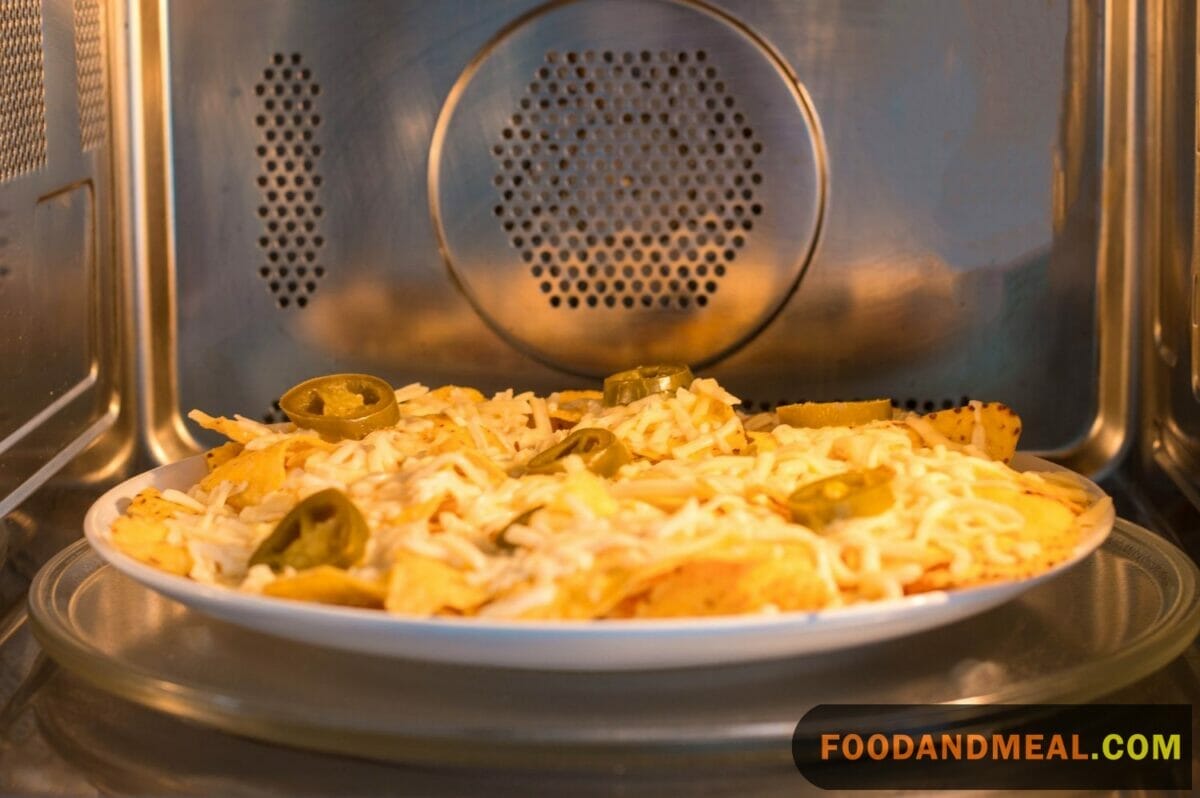If you’re in search of a convenient method for melting cheese, the microwave is undoubtedly your go-to option. In just a matter of minutes, you can achieve the ideal melted cheese for dipping or spreading on your preferred dishes.
In this blog post, Food and Meal will provide you with a straightforward and efficient guide on how to quickly and easily melt cheese in the microwave. Whether you’re preparing a cheesy dip for your upcoming gathering or simply craving a speedy snack, read on for the step-by-step instructions!
Does microwave melt cheese?
Microwaving cheese serves as a commonly adopted approach for achieving that coveted, lusciously melted texture that adds delectable appeal to a myriad of dishes, including but not limited to nachos, macaroni and cheese, and a variety of cheese-based sauces. Nevertheless, the ease and degree of success associated with this microwave cheese-melting endeavor hinge upon a multitude of factors, each playing a distinct role in the culinary outcome.

How To Melt Cheese In Microwave
If you’re on the lookout for a quick and convenient way to achieve perfectly melted cheese, the trusty microwave is your go-to kitchen companion! In just a few simple steps, you can have that velvety, molten cheese ideal for enhancing a wide range of dishes.
Before we dive into the details, let’s ensure you have everything you need:
- Cheese of your choice (while cheddar is a popular pick, feel free to go with your favorite variety).
- A microwave-safe bowl or dish.
- A reliable spoon or spatula.
- Milk (optional but a great addition for achieving a creamy consistency).
Now that your ingredients are ready, let’s proceed with the step-by-step guide on how to expertly melt cheese in the microwave:
- Step 1: Begin by prepping your cheese. To expedite the melting process, consider chopping it into small pieces. If you’re working with a hard cheese like cheddar, grating it can also be an excellent choice.
- Step 2: Place your cheese in the designated microwave-safe bowl or dish. If you’ve opted for the addition of milk, this is the perfect time to introduce it to the mix. Adding a touch of milk or cream and giving it a thorough stir will contribute to achieving that irresistibly smooth and creamy texture. In case you don’t have milk on hand, a small amount of water, just enough to cover the base of the dish, can be a viable substitute.
- Step 3: With your cheese and optional milk in the bowl, it’s time to let the microwave work its magic. Set your microwave to high and heat the mixture for a duration of 30-60 seconds. The goal is to reach the level of meltiness that suits your preference. To avoid any undesirable outcomes, make sure to check on it every 15-20 seconds, ensuring it doesn’t overheat or burn.
- Step 4: Once your cheese reaches the desired state of melted perfection, give it a gentle stir, and voilà, it’s ready to be relished! Serve this delectable melted cheese alongside a medley of accompaniments such as crackers, pretzels, or your favorite dipping sauce. Whether you’re hosting a gathering or simply craving a quick snack, this microwave-melted cheese will undoubtedly elevate your culinary experience!
Things You Should To Know Before Melting Cheese In The Microwave
Consider these recommendations for melting cheese effectively:
- Be mindful of the cheese’s consistency; harder cheeses like cheddar require more time to melt in comparison to their softer counterparts such as mozzarella.
- Prioritize shredding or finely dicing the cheese into small pieces. This not only expedites the melting process but also ensures a uniform, gooey texture.
- Enhance the melting experience by adding a small amount of liquid – whether it’s a splash of milk, a dollop of cream, or even a touch of water. This addition serves to prevent the cheese from drying out or scorching during the microwave process.
- Begin with a low microwave power setting. High heat can lead to the cheese seizing up and forming clumps, so it’s best to initiate with a gentle setting and increase the power as needed.
- Stir the cheese frequently and consistently while it’s in the microwave. This diligent stirring promotes even and smooth melting.
- Show restraint when melting cheese. It can transform rapidly from a luscious, creamy state to an undesirable, rubbery consistency. As soon as the cheese reaches your preferred level of melting, promptly remove it from the microwave.
With these tips in mind, melting cheese in the microwave becomes an effortless process! Give them a try the next time you’re preparing a grilled cheese sandwich, nachos, or any recipe that calls for perfectly melted cheese.

Is It Safe To Melt Cheese In The Microwave?
Indeed, it is perfectly safe to use the microwave for melting cheese. Cheese, being a dairy product, boasts a high protein content. When subjected to heat, these proteins undergo a transformation, transitioning into a liquid state.
The microwave harnesses electromagnetic radiation to heat food, which, it’s important to note, differs significantly from ionizing radiation, a type that has been linked to cancer and other health concerns. Microwave radiation, on the other hand, poses no risk of causing cancer or any other health issues.
However, there are some key considerations to bear in mind when melting cheese in the microwave:
First and foremost, be aware that hard cheeses like cheddar necessitate more time to melt compared to softer cheeses like mozzarella. Consequently, they are more susceptible to burning if exposed to the microwave for too long.
Second, make it a habit to stir the cheese regularly during the microwaving process. This practice helps prevent any undesirable burning.
Lastly, exercise caution and avoid overdoing it! Melted cheese can swiftly transition from a creamy, smooth consistency to a rubbery, stringy one. Remove the cheese from the microwave as soon as it reaches your preferred level of melting.
With these tips in your culinary arsenal, melting cheese in the microwave becomes a safe and convenient method for enjoying your favorite recipes. Give it a try the next time you’re preparing a grilled cheese sandwich, nachos, or any dish that requires beautifully melted cheese.
Time And Temperature Guide To Melting Different Types Of Cheese In The Microwave
Melting cheese in the microwave can be a convenient and quick way to achieve that gooey, melted goodness. However, different types of cheese have varying melting points and textures, so it’s essential to adjust the time and temperature accordingly. Here’s a general guide to melting different types of cheese in the microwave:
- Mozzarella: Mozzarella cheese is a soft and mild cheese, making it easy to melt. Start with a microwave-safe dish and place the mozzarella in it. Use a low to medium-low power setting (30-50%) and microwave in short 15-30-second bursts. After each burst, check for melting, and stir if needed. It typically takes about 1-2 minutes to melt a cup of shredded mozzarella, depending on your microwave’s wattage.
- Cheddar: Cheddar cheese is firmer and will require a bit more time to melt evenly. Use a low to medium-low power setting, similar to mozzarella, and microwave in 30-45-second intervals. Stir or check for melting after each interval. It might take around 2-3 minutes to melt a cup of shredded cheddar.
- Swiss: Swiss cheese, being hard like cheddar, requires a similar approach. Use a low to medium-low power setting, microwave in 30-45-second intervals, and stir or check for melting. It may take around 2-3 minutes to melt a cup of shredded Swiss cheese.
- Brie or Camembert: These soft, creamy cheeses should be treated delicately. Use a low power setting (30-50%) and microwave in 10-20-second intervals. Be cautious not to overheat, as they can become runny quickly. It typically takes 30 seconds to 1 minute to melt a small wheel of Brie or Camembert.
- Blue Cheese: Blue cheese is crumbly and doesn’t melt like other cheeses. Instead, use the defrost or low power setting for short bursts, around 10-15 seconds at a time. Stir or break it into smaller pieces to aid the process.
- Cream Cheese: Cream cheese is very soft and melts easily. Use a low power setting and microwave in 10-15-second intervals, stirring in between until it’s smooth and creamy. It usually takes about 30 seconds to melt a standard 8-ounce block of cream cheese.
Always exercise caution when melting cheese in the microwave, as it can turn from melted to overheated quickly. Stirring between intervals and monitoring the cheese’s progress is essential to achieve the desired consistency without burning or overheating. Adjust the times and power levels as needed based on your specific microwave’s wattage and the quantity of cheese being melted.

Reasons Why Your Cheese Isn’t Melting In The Microwave
Melting cheese in the microwave can sometimes be a tricky task, and several variables can influence the outcome. Here’s a comprehensive look at the common reasons why your cheese might not be melting as expected:
- Cheese Type: Not all cheeses are created equal when it comes to melting. Harder, drier cheeses like Parmesan and Pecorino are less prone to melting smoothly due to their lower moisture content and higher protein levels. In contrast, softer, higher-fat cheeses like Brie and Ricotta have a greater tendency to melt seamlessly.
- Microwave Power Level: The wattage of your microwave can significantly impact the melting process. If your microwave has lower power, it will take longer to melt cheese. Conversely, a high-powered microwave can cause cheese to melt too quickly, potentially leading to burning or seizing.
- Quantity of Cheese: Attempting to melt a large quantity of cheese at once can pose challenges. It may not melt evenly, resulting in some parts remaining solid while others turn into a gooey mess. To achieve more consistent results, consider melting cheese in smaller batches.
- Stirring Technique: Stirring plays a vital role in ensuring even melting. Regularly stir the cheese as it melts to distribute heat evenly and prevent clumping. A well-stirred cheese will result in a smoother consistency.
- Additional Ingredients: If you’re adding liquid ingredients like milk or cream to the cheese, it can alter its consistency and affect how it melts. Adjust the quantity of liquid added to achieve the desired texture, bearing in mind that excessive liquid can hinder even melting.
- Ingredient Temperature: The temperature of the cheese before microwaving can affect the melting time. Cheese straight from the refrigerator will take longer to melt than cheese at room temperature. Allow refrigerated cheese to come closer to room temperature before microwaving for more efficient melting.
- Microwave-Safe Dish: The choice of microwave-safe dish is essential. Glass or ceramic dishes are preferred for melting cheese in the microwave because they heat evenly and do not react with the cheese. Avoid using metal dishes, as they can cause sparking, posing a fire hazard.
By considering these factors and experimenting with different approaches, you can troubleshoot and achieve better results when melting cheese in the microwave. As with many culinary skills, practice and experience will improve your ability to consistently achieve the desired cheese-melting outcome.
Tips For The Best Melted Cheese
When it comes to melting cheese, whether it’s for a creamy sauce, a savory dip, or topping for your favorite dish, following these detailed steps will help you achieve the perfect consistency:
- Optimal Cheese Temperature: To kick-start the melting process, it’s essential to begin with cheese at room temperature. Cheese that’s not too cold will melt more smoothly and evenly than cheese straight from the fridge. Allow your cheese to sit out for a few minutes before you start melting it.
- Precise Cheese Cutting: The size of your cheese pieces plays a significant role in how they melt. For quicker and more even melting, cut the cheese into small, uniform pieces. Smaller pieces melt more efficiently than larger ones, ensuring a velvety texture.
- Microwave-Safe Container: Select a microwave-safe container that can handle the heat and promote even melting. Glass or ceramic dishes are ideal choices, as they retain heat effectively. Avoid using metal containers, as they can cause sparking and result in a ruined cheese batch.
- A Splash of Liquid: To achieve a smooth and creamy consistency, introduce a small amount of liquid. You have flexibility here—use milk, cream, water, or even beer. Add just enough liquid to cover the bottom of the container, as excessive liquid can affect the cheese’s texture.
- Stirring Vigilance: Regular stirring during the microwaving process is crucial to prevent any burning or the development of a rubbery texture. Frequent stirring ensures that the cheese is evenly heated and maintains its desired creamy state.
- Microwave Power Settings: Carefully choose your microwave’s power setting. While high power may seem like a faster route to melting, it can also be a risk factor for overcooking. Initiate the process with low or medium power settings, adjusting as needed based on your microwave’s wattage.
- Timing is Key: Keep a close eye on the melting process, as the duration in the microwave is critical. The longer you microwave the cheese, the higher the chances of it becoming dry, rubbery, or burnt. Remove the cheese from the microwave as soon as it reaches your desired level of creaminess.
By meticulously following these steps, you can confidently master the art of melting cheese. Whether you’re creating a luscious cheese sauce, a gooey dip, or simply melting cheese for a culinary delight, these detailed guidelines will ensure that your cheese reaches the perfect consistency without any hiccups. Remember that practice and experimentation are your allies in achieving cheese-melting perfection.
FAQs about Microwaving Cheese
- Q1: Can you microwave cheese without it melting? Answer: No, microwaving cheese typically causes it to melt. Cheese contains fats and moisture that, when heated, become fluid. However, the extent of melting can vary based on the type of cheese and its moisture content.
- Q2: Why does cheese melt in the microwave? Answer: Cheese contains fats and water. When exposed to heat, the fat melts, and the water turns into steam. This process causes the cheese to soften and become gooey or runny, depending on the type of cheese.
- Q3: Can you control the melting of cheese in the microwave? Answer: While you can control the melting to some extent by adjusting the microwave power and duration, cheese will inevitably melt when heated. Use lower power settings and shorter durations to slow down the melting process.
- Q4: Are there types of cheese that melt less in the microwave? Answer: Some cheeses, like aged or hard cheeses (e.g., cheddar, Swiss), may retain more of their structure when microwaved compared to softer cheeses. However, all cheeses will melt to some degree when exposed to heat.
- Q5: How can I prevent cheese from becoming too runny in the microwave? Answer: To minimize runniness, use lower power settings, microwave in short intervals, and avoid overheating. Additionally, consider adding a starch (like flour or cornstarch) or a stabilizer to the cheese before microwaving.
- Q6: Can I reheat dishes with melted cheese in the microwave? Answer: Yes, you can reheat dishes with melted cheese in the microwave. However, be cautious not to overheat, as the cheese may become overly runny or lose its desired texture.
- Q7: What are some tips for microwaving cheese for specific dishes, like nachos or cheese sauce? Answer: For dishes like nachos or cheese sauce, melt the cheese in short intervals, stir frequently, and use lower power settings to achieve a smoother texture without excessive runniness.
- Q8: Is it safe to microwave cheese in its packaging? Answer: It’s generally not recommended to microwave cheese in its packaging, especially if it’s wrapped in plastic. Remove the cheese from any packaging before microwaving to avoid potential chemical reactions or melting of plastic.
- Q9: Can I use a microwave-safe cover or wrap to contain melted cheese? Answer: Yes, covering the cheese with a microwave-safe cover or wrap can help contain the heat and prevent excessive mess. Use a cover that allows steam to escape to avoid building pressure.
- Q10: Can microwaving cheese alter its taste or texture? Answer: Microwaving can alter the texture of cheese, making it softer or gooey. While the taste is generally preserved, the texture may differ from the original form, especially if overheated.
Conclusion
In conclusion, a microwave can indeed melt cheese, and it is a commonly used method for achieving that desirable smooth and gooey consistency in various dishes. However, the effectiveness of melting cheese in a microwave depends on several crucial factors. The type of cheese chosen, the microwave’s power, the quantity of cheese being melted, and the technique employed all play significant roles in the outcome.
Different cheeses have varying melting properties due to factors like moisture content, fat content, and age. The wattage of the microwave affects the speed and uniformity of melting, and finding the right balance between time and power is key. Smaller quantities of cheese tend to melt more evenly than larger ones, and using proper techniques, such as melting slowly in short intervals with occasional stirring, is essential to avoid overcooking.
In essence, while microwaving cheese can yield deliciously melted results, it requires careful consideration of these factors to achieve the desired outcome in various culinary creations.
I'm Kelly Atkinson, with a passion for dissecting the world of home goods. My reviews stem from thorough testing and a love for sharing detailed insights. Each piece I write offers a glimpse into my explorative journey, aiming to guide readers to informed choices with authenticity and precision, making every review a blend of exploration and expertise.
